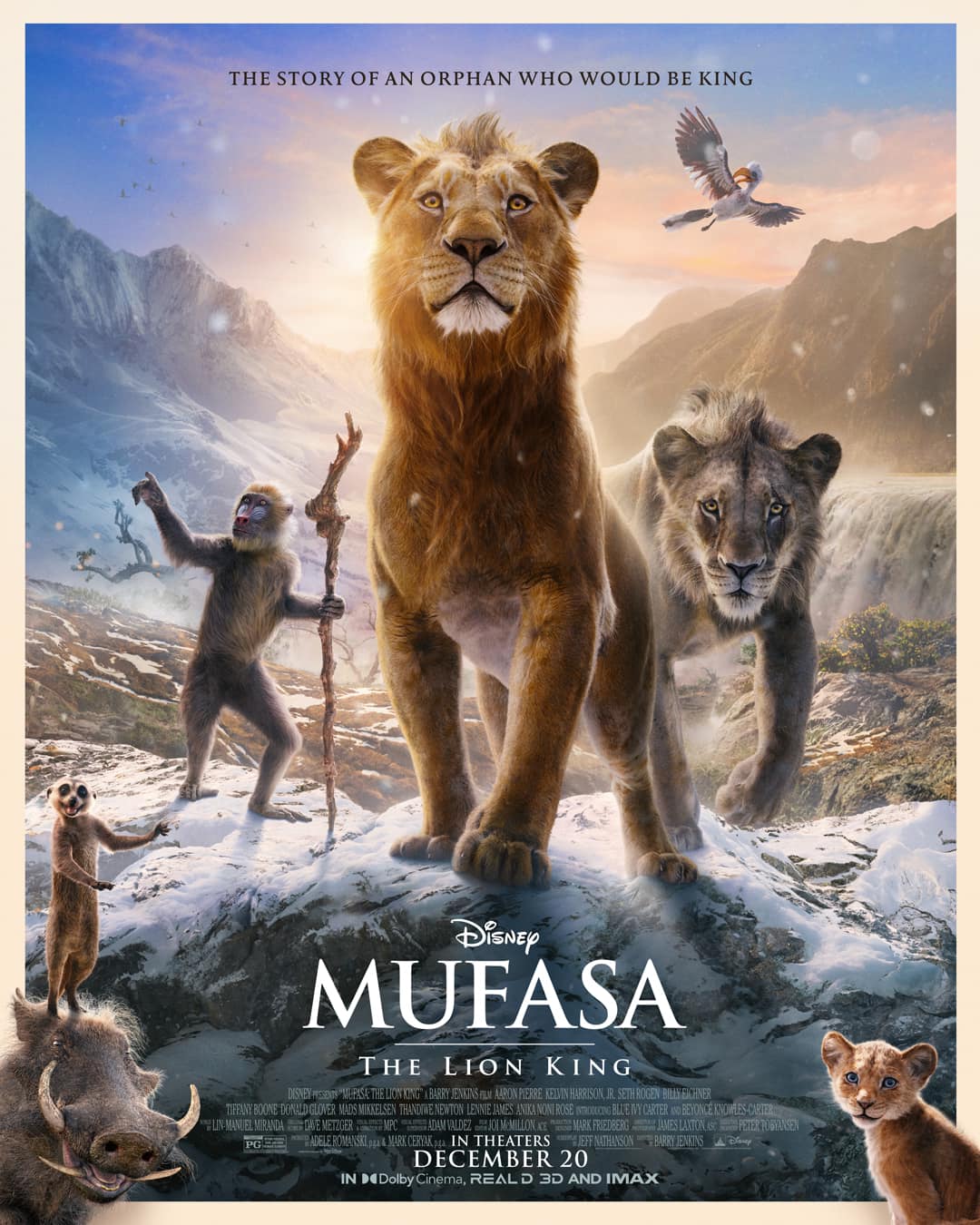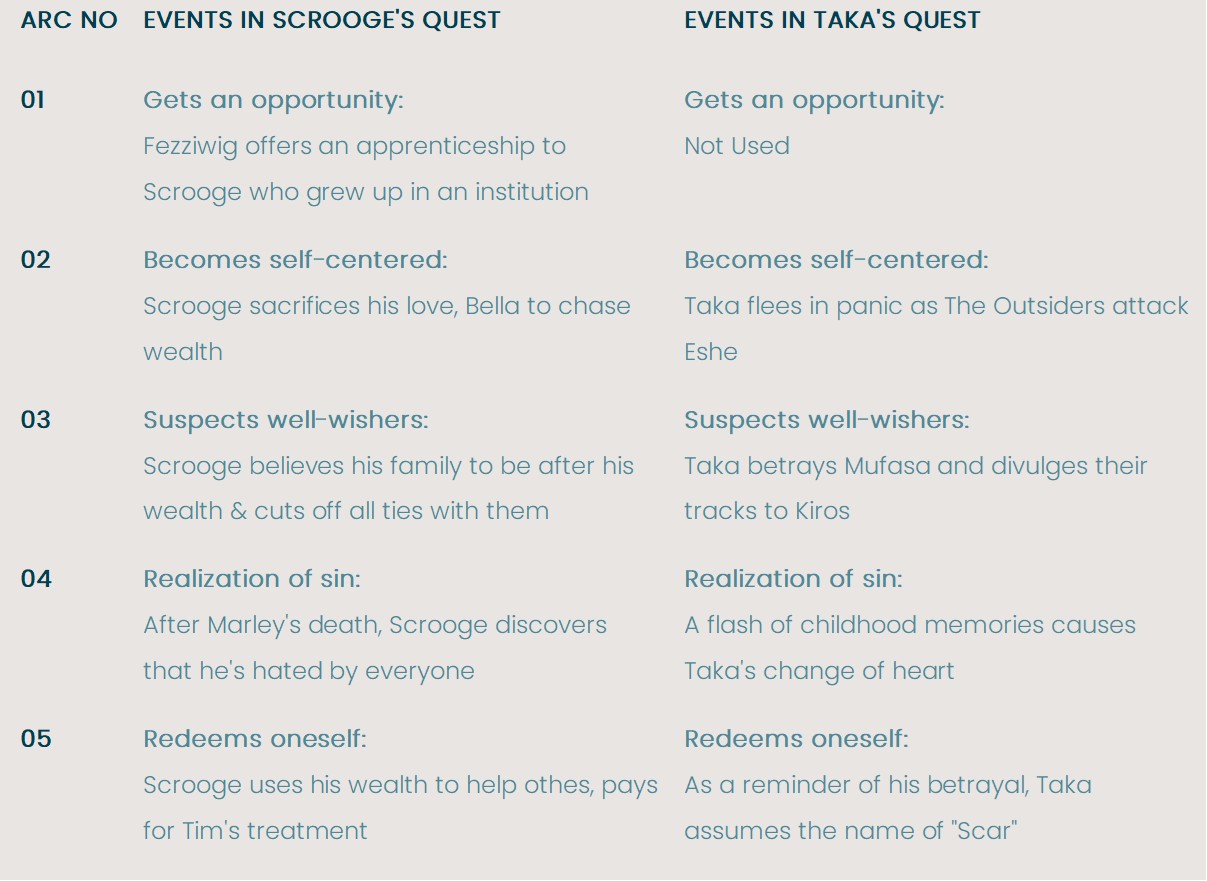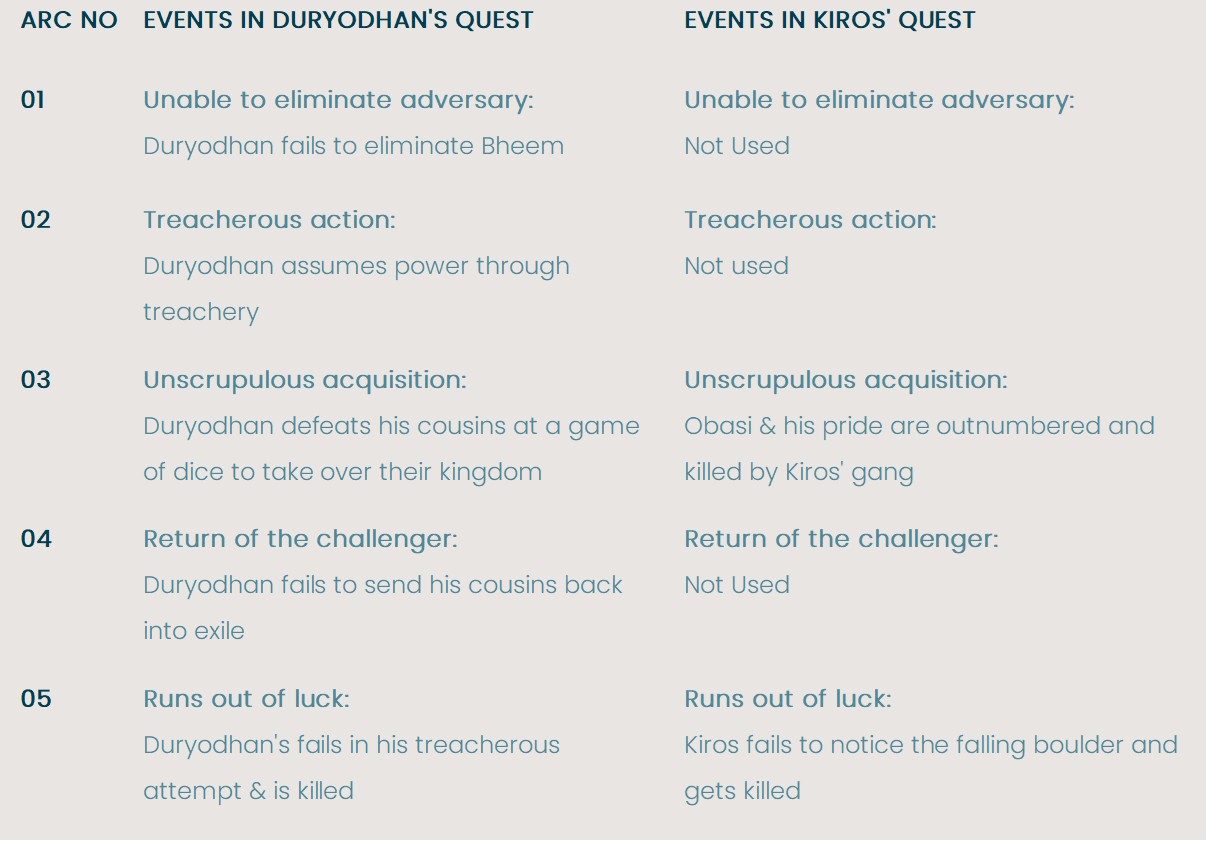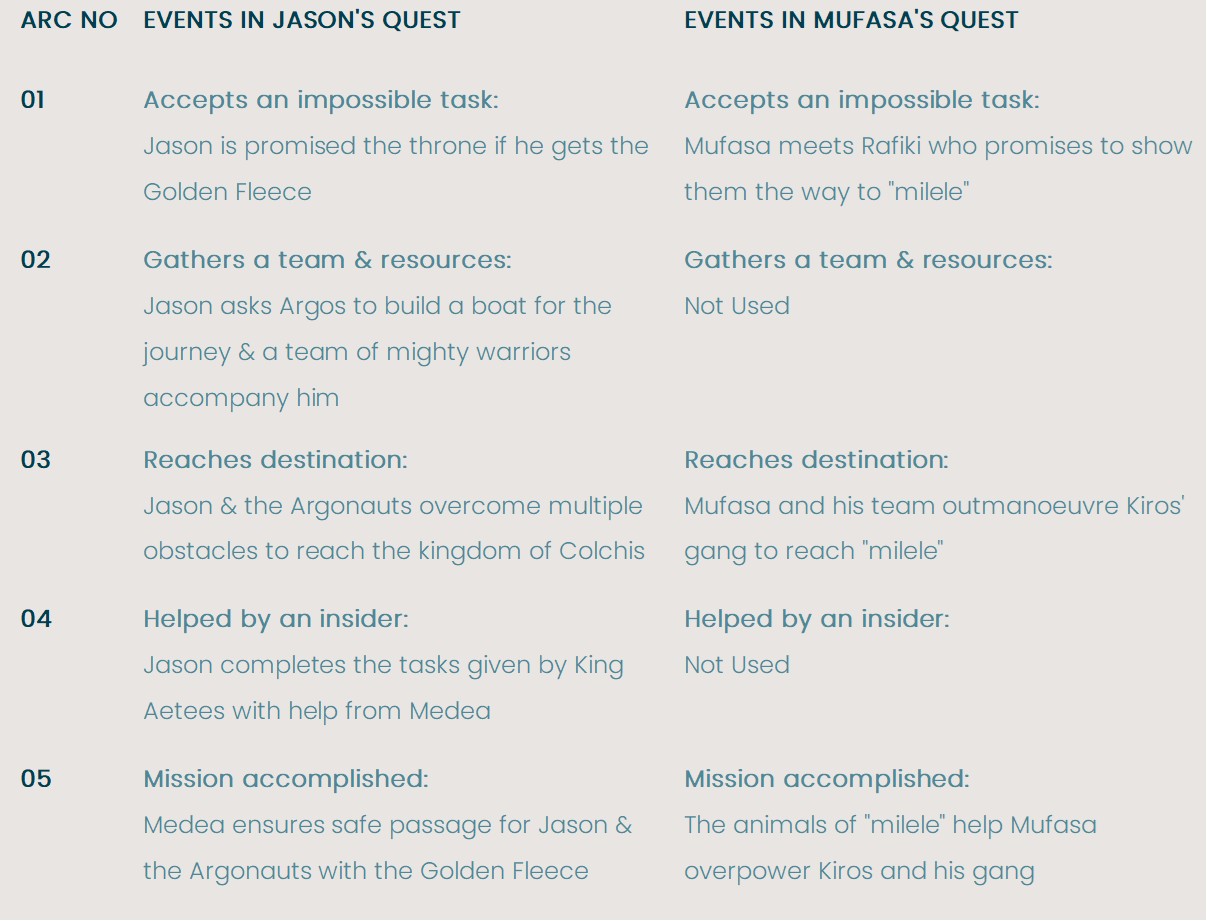A prequel with flawed, inconsistent & shallow backstories

- Script potential at Domestic box office: $150 – 221MM
- The Ideal Plot structure enhances revenues by 4X!
Mufasa: The Lion King, directed by Barry Jenkins, serves as a prequel to the 1994 classic The Lion King. It focuses on Mufasa's ascent to the throne and Scar's fall from grace. The movie fleetingly explores Sarabi’s choice of Mufasa and Rafiki’s revered status. The movie’s plot structure exposes the inconsistencies in Mufasa's quest and the flaws in Scar's moral compass.
1.The invisible plot structure of Mufasa The Lion King
1A. The script of Mufasa The Lion King borrows 98% of its events from 5 mythological tales
Mufasa’s quest is driven by the desire for finding and elusive person/object and mirrors the tale of Jason from Greek mythology. Jason’s desire to find The Golden Fleece is shared by Mufasa who wants to find “Milele”.
Mufasa has another quest driven by approval of others and mirrors the tale of Theseus from Greek mythology. Both Theseus and Mufasa get accepted by those who rejected them initially.
Taka’s quest is driven by selfishness. The quest borrows events from the tale of Valmiki from Hindu mythology. Both Valmiki & Jack are self-centred but have a change of heart and sacrifice their interest.
Taka's quest concludes with a redemption arc, highlighted by his remorse. This clashes with Taka's vengeful quest in the sequel. The transformation from remorse to vengeance remains unexplained, that is likely to leave audiences perplexed.
Kiros’ quest is driven by the desire to punish offenders. The quest borrows events from the tale of Duryodhan from Hindu mythology. Both Duryodhan and Kiros seek to avenge their humiliation.
Rafiki has an underdeveloped quest of Status. Similar to Joseph’s status getting elevated after decoding the Pharoah’s dream, Rafiki is respected by the Lions after telling them about Milele.
Sarabi doesn’t have any quest.
Detailed mirroring of each character’s primary quest to their respective mythological tales is in section “3A. Quests of characters and their mythological counterparts”
Mufasa has another quest driven by approval of others and mirrors the tale of Theseus from Greek mythology. Both Theseus and Mufasa get accepted by those who rejected them initially.
Taka’s quest is driven by selfishness. The quest borrows events from the tale of Valmiki from Hindu mythology. Both Valmiki & Jack are self-centred but have a change of heart and sacrifice their interest.
Taka's quest concludes with a redemption arc, highlighted by his remorse. This clashes with Taka's vengeful quest in the sequel. The transformation from remorse to vengeance remains unexplained, that is likely to leave audiences perplexed.
Kiros’ quest is driven by the desire to punish offenders. The quest borrows events from the tale of Duryodhan from Hindu mythology. Both Duryodhan and Kiros seek to avenge their humiliation.
Rafiki has an underdeveloped quest of Status. Similar to Joseph’s status getting elevated after decoding the Pharoah’s dream, Rafiki is respected by the Lions after telling them about Milele.
Sarabi doesn’t have any quest.
Detailed mirroring of each character’s primary quest to their respective mythological tales is in section “3A. Quests of characters and their mythological counterparts”
1B. Mufasa The Lion King’s unique plot structure extracted from our reservoir of infinite stories
Human beings are driven by 16 fundamental desires. Every desire, whether encountering fulfilment or unfulfillment, gives rise to two distinct quests. Thus, a spectrum of 32 unique quests mirrors every human desire.
We have discovered mythological tales from across civilizations that uniquely portray each one of these 32 human quests. While each mythological tale stands as a distinct quest, the true magic unfolds when these tales are combined. This synergy is evident in the epics of Odyssey and Ramayan, where various universal quests seamlessly intertwine.
Combining any five tales from the 32, generates a staggering 24 million unique story plots. Take it a step further, by combining six tales the possibilities explode to an astounding 600 million!
The plot of Mufasa The Lion King is a subset of Mythosis plot structure #465,809 that interweaves the tales of Theseus, Valmiki, Duryodhan, Jason & Joseph.
We have discovered mythological tales from across civilizations that uniquely portray each one of these 32 human quests. While each mythological tale stands as a distinct quest, the true magic unfolds when these tales are combined. This synergy is evident in the epics of Odyssey and Ramayan, where various universal quests seamlessly intertwine.
Combining any five tales from the 32, generates a staggering 24 million unique story plots. Take it a step further, by combining six tales the possibilities explode to an astounding 600 million!
The plot of Mufasa The Lion King is a subset of Mythosis plot structure #465,809 that interweaves the tales of Theseus, Valmiki, Duryodhan, Jason & Joseph.
2. The potential of Mufasa The Lion King’s plot structure: $150 – 221MM
2A. Mufasa The Lion King’s plot structure evaluation
The interweaving of 32 mythological tales creates a billion stories. We use these 32 tales to extract the plot structure of any story across genres. The study of plot structures across Blockbuster, Hit & Flop movies led to the discovery of storytelling principles. We developed Mythosis Code to see how well a story follows these principles.
- All Blockbusters have at least 3 universal quests. Mufasa the Lion King uses 5 universal quests of Acceptance, Accumulation, Vengeance, Expedition & Status.
- In Blockbusters, each universal quest is mirrored by ONLY ONE character. Mufasa mirrors the universal quest of Acceptance & Expedition. Kiros mirrors the universal quest of Vengeance. Taka mirrors the universal quest of Accumulation. Rafiki mirrors the universal quest of Status.
- Every Blockbuster character borrows at least 35% of the universal quest. Taka borrows 32% events from the quest of Accumulation. Mufasa borrows 33% from the quest of Expedition and 19% from the quest of Acceptance. Kiros borrows 21% from the quest of Vengeance. Rafiki borrows 9% from the quest of Status.
- Blockbusters interweave different quests to create a tight plot structure. Interweaving occurs when events of 2 quests occur simultaneously in the story. Blockbusters have a quest interweaving threshold of 0.5. Mufasa the Lion King’s quest interweaving score of 0.40 is below par. An example of interweaving the quests of Mufasa & Kiros:

2B. Estimating Mufasa The Lion King’s revenue potential from its plot structure
The plot structure of Mufasa the Lion King has the advantage of 2 powerful character quests. However, it is weakened by the inconsistency in Mufasa’s quest and low interweaving between quests.
We have created an algorithm by assigning weights to the principles of The Mythosis Code. This algorithm has an accuracy of 91% in predicting the lifetime revenue of a movie from its script. The algorithm calculates the potency of a story’s plot structure and estimates how many people will like the story. The number of people and current ticket prices gives us the box-office revenue.
Blockbuster plot structures have a score of at least 0.64 and appeal to 20% of the audiences. Mufasa The Lion King has a script potential score is 0.14 and the movie will appeal to 3.90% - 5.32% of the population.
Our estimate of the movie's revenues from its script is $150–221MM in the domestic market.
We have created an algorithm by assigning weights to the principles of The Mythosis Code. This algorithm has an accuracy of 91% in predicting the lifetime revenue of a movie from its script. The algorithm calculates the potency of a story’s plot structure and estimates how many people will like the story. The number of people and current ticket prices gives us the box-office revenue.
Blockbuster plot structures have a score of at least 0.64 and appeal to 20% of the audiences. Mufasa The Lion King has a script potential score is 0.14 and the movie will appeal to 3.90% - 5.32% of the population.
Our estimate of the movie's revenues from its script is $150–221MM in the domestic market.
3. The ideal plot structure of Mufasa The Lion King
We have identified 32 mythological tales, the superset of all tales across cultures. The quests of these tales have also recurred over time periods. They represent human behaviours that are deeply embedded in our shared memories. Each tale is the richest expression of the pursuit of a human desire. The tales have a unique pattern of events spread over 5 major arcs.
Mapping a character’s quest to the relevant mythological tale reveals the gaps in their quest, if any. Plugging these gaps with the missing events deepens the character quest. The missing events also provide an opportunity for interweaving the various quests. These events strengthen the story and unlock its hidden potential.
Mapping a character’s quest to the relevant mythological tale reveals the gaps in their quest, if any. Plugging these gaps with the missing events deepens the character quest. The missing events also provide an opportunity for interweaving the various quests. These events strengthen the story and unlock its hidden potential.
3A. Quest of characters and their mythological counterparts
Quest 1: Taka mirrors the universal quest for Accumulation
Taka’s desire for Accumulation stems from the need to collect and own. The tale of Valmiki from Hindu mythology has a robust expression in Dicken’s character of Scrooge which is the universal quest for Accumulation.

Quest 2: Kiros mirrors the universal quest for Vengeance
Kiros' desire for Vengeance stems from the need to punish offenders. The tale of Duryodhan from Hindu mythology is the universal quest for Vengeance.

Quest 3: Mufasa mirrors the universal quest for Expedition
Mufasa's desire for Expedition stems from the need to find an elusive person/object. The tale of Jason from Greek mythology is the universal quest for Expedition.

3B. Gaps in the current plot structure
The plot structure is weakened by the inconsistent quest of Mufasa and low interweaving between quests. Additionally, it misses an opportunity by failing to strengthen the quests of all the 4 characters.
The fundamental flaw with the plot structure is the choice of Taka’s quest. Taka's universal quest concludes with a redemption arc, highlighted by his remorse. This clashes with Taka's quest of vengeance in the sequel, as the transformation from remorse to vengeance remains unexplained.
The fundamental flaw with the plot structure is the choice of Taka’s quest. Taka's universal quest concludes with a redemption arc, highlighted by his remorse. This clashes with Taka's quest of vengeance in the sequel, as the transformation from remorse to vengeance remains unexplained.
3C. Unlocking the hidden potential
Mufasa The Lion King’s script is a subset of Mythosis Plot structure #465,809.
a. The revenue potential of Mufasa’s script is drastically enhanced by borrowing the missing events from this plot structure.
b. The additional events deepen the quests of Mufasa, Taka, Kiros and Rafiki.
c. They also improve the interweaving of their quests.
d. This plot structure amends Mufasa’s inconsistent character graph by borrowing only from Jason’s quest and not Theseus’ quest.
e. However, it doesn’t address Taka’s flawed transition from remorse to vengeance.
Mythosis has found a universal quest that explains Taka’s transformation from a friend into a foe. Mythosis Plot structure #485,820 replaces Valmiki’s quest with Kaikeyi’s quest from Hindu mythology. Kaikeyi’s quest is the most appropriate journey that perfectly explains Taka’s transformation into Scar.
Mythosis Plot structure #485,820 enhances current revenues by ~4X!
a. The revenue potential of Mufasa’s script is drastically enhanced by borrowing the missing events from this plot structure.
b. The additional events deepen the quests of Mufasa, Taka, Kiros and Rafiki.
c. They also improve the interweaving of their quests.
d. This plot structure amends Mufasa’s inconsistent character graph by borrowing only from Jason’s quest and not Theseus’ quest.
e. However, it doesn’t address Taka’s flawed transition from remorse to vengeance.
Mythosis has found a universal quest that explains Taka’s transformation from a friend into a foe. Mythosis Plot structure #485,820 replaces Valmiki’s quest with Kaikeyi’s quest from Hindu mythology. Kaikeyi’s quest is the most appropriate journey that perfectly explains Taka’s transformation into Scar.
Mythosis Plot structure #485,820 enhances current revenues by ~4X!
- Tags: Character development, Long range prediction, Mufasa The Lion King, Mythology, Plot Structure, storytelling
